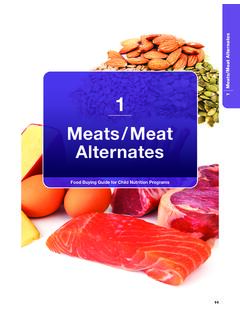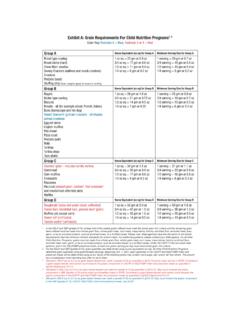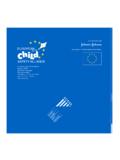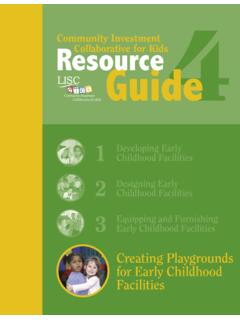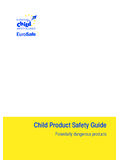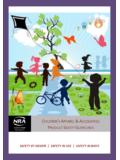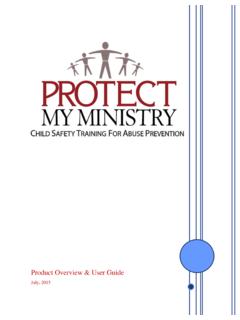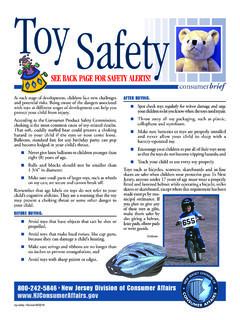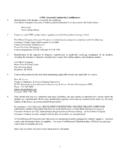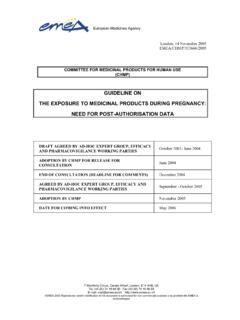Transcription of Food Buying Guide for Child Nutrition Programs
1 Food and Nutrition Service Food Buying Guide for Child Nutrition Programs The contents of this guidance document do not have the force and effect of law and are not meant to bind the public in any way. This document is intended only to provide clarity to the public regarding existing requirements under the law or agency policies. 3 In accordance with Federal civil rights law and Department of Agriculture (USDA) civil rights regulations and policies, the USDA, its Agencies, offces, and employees, and institutions participating in or administering USDA Programs are prohibited from discriminating based on race, color, national origin, religion, sex, gender identity (including gender expression), sexual orientation, disability, age, marital status, family/parental status, income derived from a public assistance program, political beliefs, or reprisal or retaliation for prior civil rights activity, in any program or activity conducted or funded by USDA (not all bases apply to all Programs ).
2 Remedies and complaint fling deadlines vary by program or incident. Persons with disabilities who require alternative means of communication for program information ( , Braille, large print, audiotape, American Sign Language, etc.) should contact the responsible Agency or USDA s TARGET Center at (202) 720-2600 (voice and TTY) or contact USDA through the Federal Relay Service at (800) 877-8339. Additionally, program information may be made available in languages other than English. To fle a program discrimination complaint, complete the USDA Program Discrimination Complaint Form, AD-3027, found online at How to File a Program Discrimination Complaint ( ) and at any USDA offce or write a letter addressed to USDA and provide in the letter all of the information requested in the form.
3 To request a copy of the complaint form, call (866) 632-9992. Submit your completed form or letter to USDA by: (1) mail: Department of Agriculture, Offce of the Assistant Secretary for Civil Rights, 1400 Independence Avenue, SW, Washington, 20250-9410; (2) fax: (202) 690-7442; or (3) email: USDA is an equal opportunity provider, employer, and lender. Updated by: Child Nutrition Programs Nutrition , Education, Training, and Technical Assistance Division Food and Nutrition Service Department of Agriculture Food Buying Guide for Child Nutrition Programs 4 Buy American Requirement The Buy American Provision is a very important provision in the National School Lunch and Breakfast Programs (NSLP/SBP). This provision does not apply to Child and Adult Care Food Program (CACFP) sponsors who are not school food authorities operating the NSLP/SBP.
4 This provision requires that a school food authority purchase, to the maximum extent practicable, domestic commodities or products. The term domestic commodity or product means an agricultural commodity that is produced in the United States or a food product that is processed in the United States substantially using agricultural commodities that are produced in the United States. The defnition of substantially means that over 51% of the fnal processed product consists of agricultural commodities that were grown domestically; however, exceptions to purchase domestic foods are very limited. These limited exceptions are only permitted after frst considering domestic alternatives and when domestic foods are unavailable or prohibitively expensive. Department of Agriculture Food and Nutrition Service FNS-634 Revised February 2020 Table of Contents Introduction Food Buying Guide for Child Nutrition Programs Table of Contents Introduction.
5 I-1 What s included in this Guide ? .. I-3 Yields .. I-4 In-House Yield Data .. I-5 Meal Patterns .. I-6 Chart 1A: School Breakfast Program (SBP) ..I - 7 Chart 1B: National School Lunch Program (NSLP) .. I-8 Chart 2: National School Lunch Program (NSLP) for Afterschool Snack Service .. I-9 Chart 3: Summer Food Service Program Meal Pattern for Children and Adults .. I-10 Chart 4: Child and Adult Care Food Program Meal Pattern for Children and Adults 4A: Breakfast .. I-11 4B: Lunch and Supper .. I-12 4C: Snacks .. I-13 4D: Infant .. I-14 Chart 5: Preschool Meal Pattern 5A: Breakfast .. I-15 5B: Lunch .. I-16 5C: Snacks .. I-17 To Help You Use This Guide ..I-18 Table 1: Abbreviations and Symbols .. I-18 Common Can and Jar Sizes per Can ..I-19 Table 2: Common Can and Jar Sizes.
6 I-19 Table 3: Common Can and Jar Sizes per Case and Principal Products ..I-20 Substituting Can Sizes .. I-23 Table 4: Guide for Substituting Cans ..I-23 Decimal Equivalents .. I-24 Table 5: Decimal Weight Equivalents ..I-24 Table 6: Decimal Equivalents of Commonly Used Fractions ..I-25 i ii Food Buying Guide for Child Nutrition Programs Table 7: Converting Decimal Equivalents to Nearest Portion of a Cup for Fruits and Vegetables ..I-25 Table 8: Decimal Equivalents for Fractions of a Unit, Fraction or Part of the Unit ..I-26 Metric Equivalents .. I-28 Table 9: Guide to Metric Conversions ..I-28 Table 10: Metric Equivalents by Weight ..I-28 Table 11: Metric Equivalents by Volume ..I-28 Table 12: Guide to Volume Equivalents for Liquids ..I-29 Measuring for Portion Control.
7 I-30 Table 13: Sizes and Capacities of Scoops (or Dishers) ..I-30 Table 14: Sizes and Capacities of Ladles ..I-31 Table 15: Sizes and Capacities of Measuring-Serving Spoons ..I-31 Explanation of the Food Buying Guide for Child Nutrition Programs .. I-33 How are the foods in this Guide listed and grouped? .. I-33 What information do the yield tables provide? .. I-33 How can you use the yield data? .. I-35 Working with the Food Buying Guide for Child Nutrition Programs .. I-36 Calculating how much food you need for a given number of servings ..I-36 Method 1: Using Column 3 ..I-38 Example A: Carrot Slices, cooked ..I-38 Example B: Ground Beef, fresh or frozen (no more than 15% fat) ..I-39 Example C: Beef Round Roast, fresh or frozen, without bone 1/4 inch trim .. I-40 Example D: Baked Beans, vegetarian, canned.
8 I-41 Example E: Nut Butters (including peanut butter) .. I-42 Example F: Eggs, large, shell, fresh .. I-42 Example G: Cereals and Cereal Grains .. I-43 Method 2: Using Column 5 .. I-44 Example A: Turkey Meatloaf .. I-44 Example B: Green Beans, frozen, cut .. I-45 Example C: Converting Column 5 yield data .. I-45 Method 3: Using Column 6 .. I-47 Example A: Broccoli, fresh, ready-to-cook .. I-47 Example B: Lettuce, fresh, Romaine, untrimmed .. I-47 Example C: Butternut Squash, fresh, cubed, cooked .. I-48 How to Make Cost Comparisons .. I-49 Comparing Cost of Cut Green Beans .. I-49 Food Categories Section 1: Meats/Meat Alternates ..1-1 Meats/Meat Alternates Component for the Child Nutrition Programs ..1- 2 Optional Best Practices for All Child Nutrition Programs ..1- 3 Defnitions.
9 1- 4 Yields ..1- 5 Explanation of the Columns ..1- 6 Yield Data Table for Meats/Meat Alternates .. 1-7 Section 2: Vegetables .. 2 -1 Vegetables Component for the Child Nutrition Programs .. 2-2 Crediting of Vegetables .. 2-4 Crediting of Vegetable Concentrates (Tomato Paste and Tomato Puree).. 2-4 Factors Affecting Yields .. 2-5 Defnitions .. 2-5 Products That Do Not Meet Requirements .. 2-6 Information Included In This Section .. 2-6 Explanation of the Columns ..2-7 Yield Data Table for Vegetables .. 2-8 Section 3: Fruits .. 3 -1 Fruits Component for the Child Nutrition Programs .. 3-2 Crediting of Fruits .. 3-4 Crediting of Fruit Juice Concentrates / How to Use Information on Concentrates .. 3-4 Factors Affecting Yields .. 3-5 Defnitions .. 3-5 Products That Do Not Meet Requirements.
10 3-6 Information Included in This Section .. 3-6 Explanation of the Columns ..3 -7 Yield Data Table for Fruits .. 3-8 Section 4: Grains .. 4 -1 Grains Component for the Child Nutrition 4-2 Defnitions .. 4-3 Examples of Foods That Are Creditable toward the Grains Component .. 4-4 Criteria for Determining Acceptable Grain Items .. 4-6 What Foods Meet the Whole Grain-Rich Criteria? ..4 -7 Does My product Meet the Whole Grain-Rich Criteria? ..4 - 1 0 Criteria for Determining Ounce Equivalents ..4 -1 1 Worksheet for Calculating Grains Contribution Using Grams of Creditable Grains ..4 - 1 3 Exhibit A: Grain Requirements for Child Nutrition Programs ..4 - 1 5 Table of Contents iii iv Food Buying Guide for Child Nutrition ProgramsInstructions for Using Yield Data ..4 - 1 8 Explanation of Columns.
